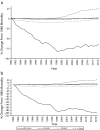America's Declining Well-Being, Health, and Life Expectancy: Not Just a White Problem
- PMID: 30252522
- PMCID: PMC6221922
- DOI: 10.2105/AJPH.2018.304585
America's Declining Well-Being, Health, and Life Expectancy: Not Just a White Problem
Abstract
Although recent declines in life expectancy among non-Hispanic Whites, coined "deaths of despair," grabbed the headlines of most major media outlets, this is neither a recent problem nor is it confined to Whites. The decline in America's health has been described in the public health literature for decades and has long been hypothesized to be attributable to an array of worsening psychosocial problems that are not specific to Whites. To test some of the dominant hypotheses, we show how various measures of despair have been increasing in the United States since 1980 and how these trends relate to changes in health and longevity. We show that mortality increases among Whites caused by the opioid epidemic come on the heels of the crack and HIV syndemic among Blacks. Both occurred on top of already higher mortality rates among all Americans relative to people in other nations, and both occurred among declines in measures of well-being. We believe that the attention given to Whites is distracting researchers and policymakers from much more serious, longer-term structural problems that affect all Americans.
Figures



References
-
- Oeppen J, Vaupel JW. Broken limits to life expectancy. Science. 2002;296(5570):1029–1031. - PubMed
-
- Crimmins EM, Saito Y. Trends in healthy life expectancy in the United States, 1970–1990: gender, racial, and educational differences. Soc Sci Med. 2001;52(11):1629–1641. - PubMed
-
- Muennig PA, Glied SA. What changes in survival rates tell us about US health care. Health Aff (Millwood) 2010;29(11):2105–2113. - PubMed
Publication types
MeSH terms
Grants and funding
LinkOut - more resources
Full Text Sources
Other Literature Sources
Medical

